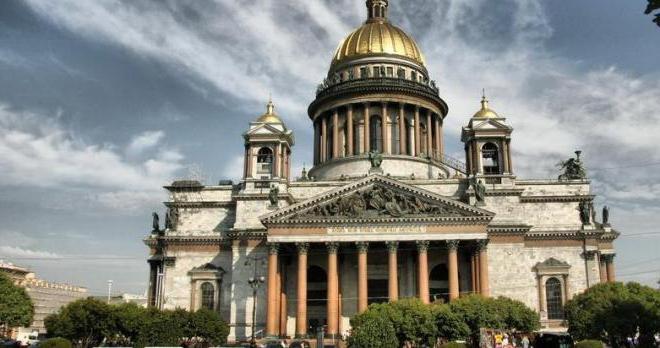The world-famous cultural capital of Russia - St. Petersburg - captivates not only local residents, but also thousands of guests who want to visit the city of bridges and white nights. What makes St. Petersburg so attractive and who made it the way we know it now?
Start of construction of St. Petersburg
The founder of the city was the great reformer and Tsar Peter I. Impressed by the architecture and development of the Western countries he visited, Peter I decided to build a city in Russia that is not inferior in beauty and sophistication to European capitals. Thus began the construction of St. Petersburg.
The Tsar was not a fanatical supporter of everything Western, but he was able to extract the most important from what he saw and adapt it to the conditions of Russia. The architects of St. Petersburg, whom he invited to work from abroad, were famous masters of this craft in European countries.
Among them are Jean-Baptiste Leblond from France and Domenico Trezzini from Italy. Their task was not only to design buildings in accordance with the tastes and needs of residents, but also to teach the architects of the empire this difficult art. To encourage foreigners, Peter I paid them a much greater reward than the Russian masters.
Architects of St. Petersburg
One of the first architects in St. Petersburg from 1703 to 1716 was Domenico Trezzini, a representative of the early Baroque. Among his projects - the construction of Kronshlot (artillery fort for protection against the Swedes); first master plan of the city; development plan of Vasilievsky island; plans for the construction of the Peter and Paul Fortress Cathedral, the Summer Palace, the building of the Twelve Colleges. The style of the architect changed under the influence of reality surrounding him. The first projects (in particular, the bell tower of the Peter and Paul Cathedral) embodied the harsh Scandinavian style in architecture. However, under the influence of the traditions and style of the Russian masters, the architectural forms of Trezzini took a softer outline.

Other architects of St. Petersburg were also affected: the peculiarities of the Russian spirit and the way of life of the peoples of the Russian Empire made significant adjustments to the creative process and the aesthetic views of architects.
An equally important contribution to urban development was made by Georg Johann Mattarnovi, a German architect who arrived in St. Petersburg in 1714. He led the construction of several buildings - the second Winter Palace, the Kunstkamera building, St. Isaac's Cathedral. But after his sudden death in 1719, the project had to be completed by the architect Nikolaus Gerbel.
Another outstanding architect who worked in the Northern capital is the Frenchman Jean-Baptiste Leblond. He was the author of the first master plan of the city. In addition, the architect created the layout of the Summer Garden, as well as parks and gardens in Strelna and Peterhof (in particular, he built the Hermitage, Monplaisir, the royal chambers and pavilions of Marly).
One of the first monumental projects was the Menshikov Palace, the construction of which began in 1710 by the development of Giovanni Maria Fontana and was completed in 1720 by Johann Schedel. The building was built specifically for the king’s favorite - Prince Alexander Menshikov.
The architects who built St. Petersburg worked for generations. So, in 1716, Bartolomeo Carlo Rastrelli arrived in the city with his family and assistants, who concluded a three-year contract with the king. The architect was engaged in the creation of a whole group of bas-reliefs for the Grand Cascade in Peterhof; created the equestrian monument of Peter I (installed in front of the Mikhailovsky Castle), as well as several portraits of the king and his "wax person".
Chief Architect of St. Petersburg
The son of Bartolomeo Sr. - Bartolomeo Francesco Rastrelli - arrived in the city with his father at the age of 15 years. He was trained by such outstanding architects as D. Trezzini, N. Michetti, M. Zemtsov and A. Schlütter. Rastrelli Jr. worked in St. Petersburg for about fifty years, creating world-famous structures during this period: the Catherine Palace in Tsarskoye Selo, the houses of Count Stroganov and Vorontsov, and the Grand Peterhof Palace. The architect of the Winter Palace in St. Petersburg is the name of Bartolomeo Rastrelli, who embodied all his skills in this complex. Construction was carried out from 1754 to 1762. After its completion, the palace became the main winter imperial residence. The building is baroque. It is the last monumental building, embodying the manner of the craftsmen who worked in this direction.

It happened so because the second half of the 18th century is characterized by sharp changes in economic relations and tastes of society, which led to the rapid fading of the popularity of Baroque.
The architect of the Winter Palace in St. Petersburg experienced a real tragedy in connection with a sharp loss of interest in the architectural style of his life, giving way to classicism. It is rare for a master to survive the era of the current in which he created. For Rastrelli, this was a real blow.
The influence of foreigners on Russian architecture
The first half of the 18th century became a landmark in the history of Russian architecture. Despite the fact that the famous architects of St. Petersburg were foreigners, they largely determined the development of architecture in the Russian Empire, endowing it partly with Western trends. At the same time, the masters themselves, under the influence of the environment, mores and traditions of the Russian people and their worldview, changed the style of their work, adapting to the tastes and preferences of customers.